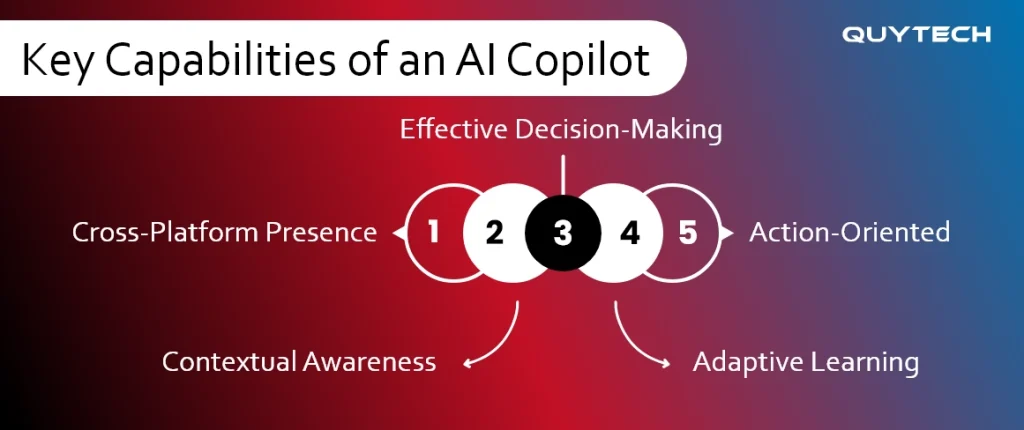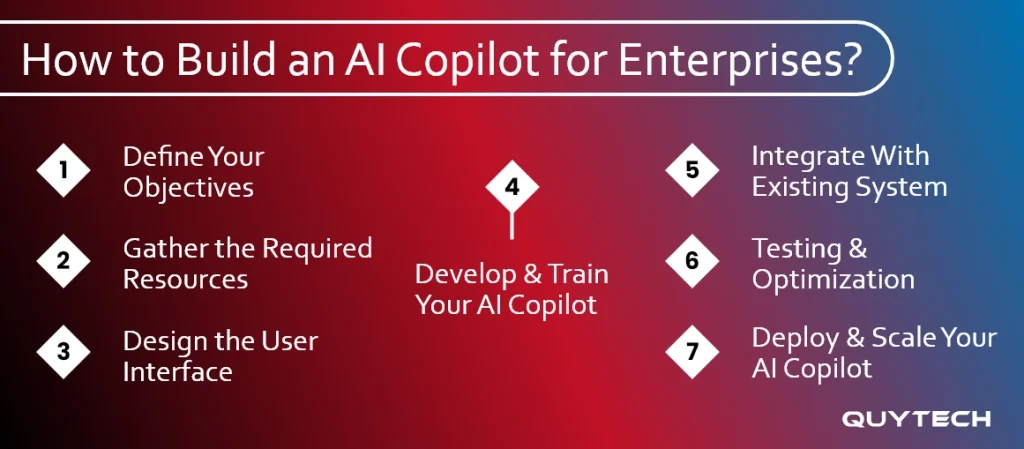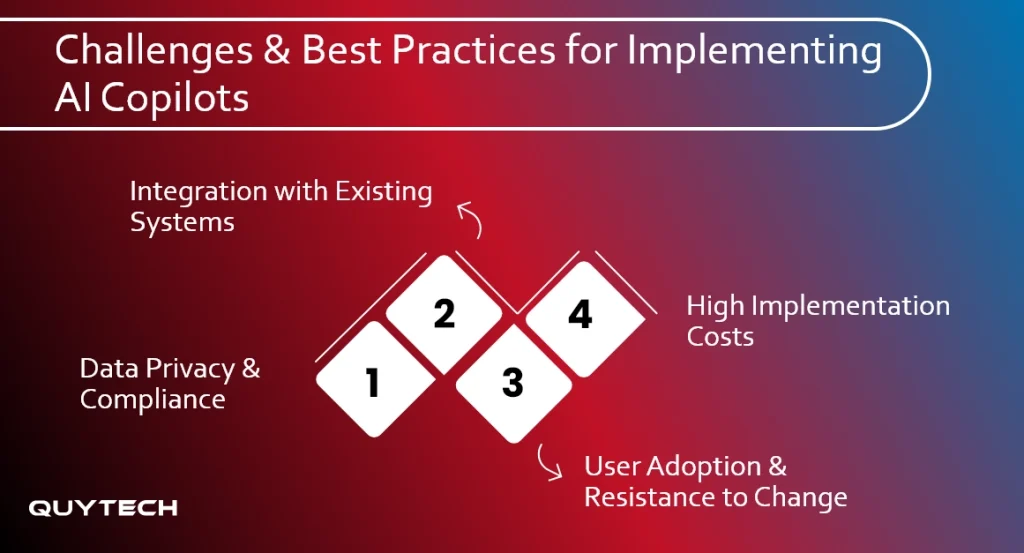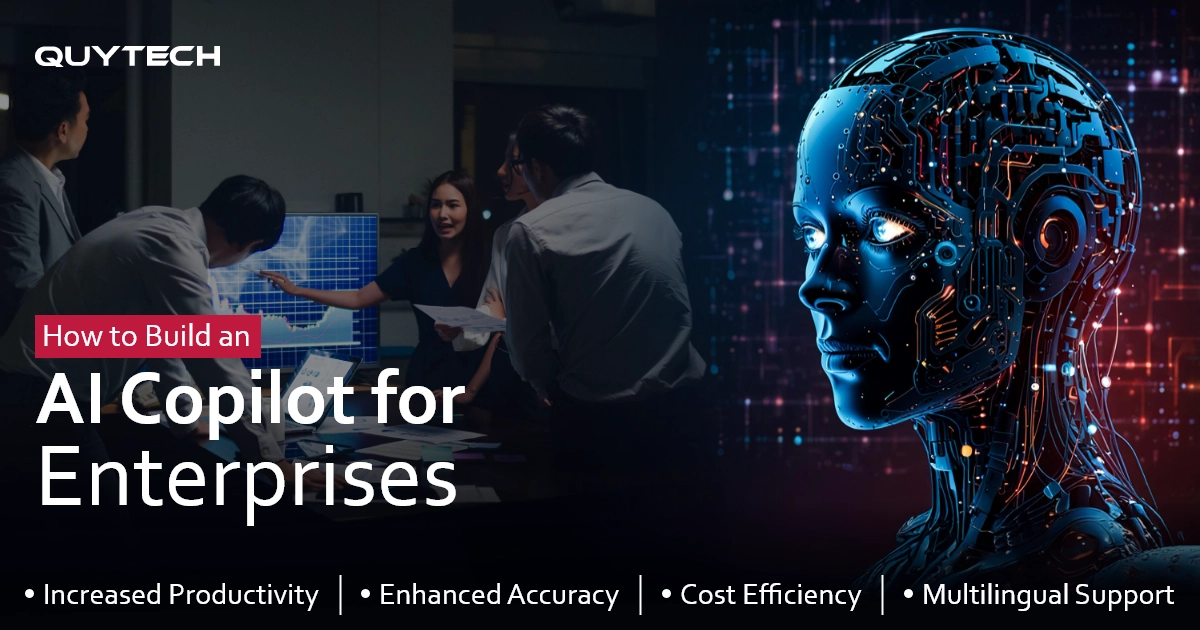We’ve entered an era where every enterprise is implementing technologies to transform its operations and rise above tough competition. And in times like these, enterprises have found their true companion, ‘AI Copilot’. With a CAGR of 26.7% from 2024 to 2035, AI Copilots are emerging as the driving force behind the next wave of enterprise evolution.
AI Copilot can be defined as an intelligent assistant that plays a significant role in redefining enterprise operations. It utilizes advanced NLP, gen AI, and contextual intelligence to assist with tasks ranging from basic email management to automating routine tasks. It understands context, carries out tasks, and adapts to user preferences.
In this blog, we will explore everything from key capabilities and benefits to steps to develop an AI Copilot. Read and find answers to all your curiosities!
Key Takeaways:
- AI Copilot is a digital assistant that assists users in carrying out tasks efficiently by automating repetitive tasks.
- It is cross-platform supported, context-aware, adaptive, and action-oriented.
- It helps enterprises reduce costs, accelerate innovation, and optimize resource use.
- AI Copilot benefits enterprises by increasing productivity, accuracy, and providing multilingual support.
- Future trends include hyper-personalization, multimodal support & Agentic AI integration.
What is an AI Copilot?
AI Copilot, as the name suggests, is like a digital companion capable of assisting humans in working more efficiently by automating routine workflows. The core technologies it utilizes for this purpose include NLP, ML, Gen AI, and contextual intelligence. With the help of these, AI copilots interact, understand context, assist with tasks, and improve their performance.
In a traditional setting, routine tasks are handled manually. This not only makes the process time-consuming but also prone to error as it’s carried out by humans. Since every basic task gets carried out manually, decision-making is also manual. Intuitions and experience rule the decision-making process. Being handled manually, the results often do not align with what is actually needed at the point. This often leads to resource wastage, a decline in productivity, and ineffective strategies.
The tables turn when AI Copilot is integrated into operations. It automates the routine tasks that free up the workforce to focus on more important tasks rather than monotonous ones. AI Copilot is powered by contextual intelligence. This makes it capable of understanding what is needed, analyzing what is available, and giving out the best possible outcome.
What truly makes AI Copilot shine is its ability to assist like an actual assistant. Unlike traditional automation that acts under rigid directions, AI Copilot brings a human touch to automation. Apart from basic assistance, it also provides insights derived through data analysis. These insights assist enterprises in making informed decisions.
Key Capabilities of an AI Copilot
To understand how an AI Copilot is different from traditional automated bots, it’s necessary to understand its capabilities. Here are some of the key capabilities of an AI Copilot:

Cross-Platform Presence
Unlike traditional automated bots, AI Copilots have a cross-platform presence. They are not limited to certain applications; they can be accessed across different platforms without having to perform integration separately.
Contextual Awareness
When it comes to contextual awareness, AI Copilot stands out with its ability to go beyond basic keyword-based intents. It can understand the meaning, intent, and situation behind the user’s actions.
Effective Decision-Making
What truly makes AI Copilots shine is their ability to understand data and make sense out of it. AI Copilots analyze data trends and guide the decision-making process. This capability of AI Copiots contributes to making effective data-driven decisions.
Adaptive Learning
Unlike traditional automation bots, AI Copilots can learn from every interaction they have with the user. They utilize advanced technologies to adapt their performance based on users’ behavior.
Action-Oriented
When it comes to being action-oriented, AI Copilots set the bar high by not just suggesting but initiating the right actions for every situation. Unlike traditional bots that wait for approvals for every action, AI Copilots autonomously take actions as per the requirements of the situation.
Why Do Enterprises Need an AI Copilot?
Enterprises, on a daily basis, conduct a lot of monotonous tasks that are often handled manually. Being routine in nature, these tasks tire out employees, affecting not just their speed but also the quality of work. The need to enhance efficiency and effectiveness also adds to the reasons why enterprises need an AI Copilot. Let’s take a glance at some of these reasons:
Reducing High Operational Costs
In the traditional setting, data-related tasks like its management often took a lot of time, effort, and resources of enterprises. Being handled manually, the quality of the outcomes also varied and was often compromised. This inaccuracy and need for manual maintenance escalates the operational costs.
In such a scenario, enterprises need an AI Copilot for automating these monotonous data-related tasks. It eliminates the need for manual intervention and frees up human resources to focus on higher-level tasks.
Accelerating Innovation and Time-to-Market
AI Copilots eliminate the need for manual research. Instead, they come out in the forefront to help enterprises do this heavy lifting. AI Copilots handle the research part right from gathering data to predicting outcomes and solutions.
This helps enterprises in speeding up their innovation, which otherwise would take longer. Faster time-to-market helps enterprises gain a strong stance in the environment.
Enhancing Customer and Employee Engagement
As mentioned already, an AI Copilot speeds up the time-to-market. This means that the customers get what they desire without having to wait for long durations. With the help of context engines, the AI Copilot can also offer personalized support, enhancing overall customer experience.
Along with this, AI Copilot contributes to enhancing employee engagement. It does so by automating repetitive tasks, cross-platform data retrieval, and decision assistance.
Improving Resource Utilization & Productivity
Investing in AI Copilot ensures improvement in resource utilization and productivity. An AI Copilot makes use of RPA, AI-powered analytics, machine learning, etc., to analyze the requirements of every task carried out by every employee. Based on this analysis, it allocates resources effectively.
This means that each task is allotted the right amount of resources, eliminating wastage and contributing to enhanced productivity in all aspects.
Read More: How AI Agents are Redefining Enterprise Productivity
How to Build an AI Copilot for Enterprises?
While planning to build an AI Copilot for enterprises brings significant benefits, the process can be challenging. But not anymore! We have broken down every step for you. Here’s how it goes:

Define Your Objectives
Every enterprise has its own unique requirements, expertise, and way of operating. So to ensure that the AI Copilot you build aligns with your enterprise’s needs, the first thing that you have to do is define your objectives. Highlight the use case where you feel that an AI Copilot could contribute to driving efficiency. This will help in creating a clear track to follow.
Gather the Required Resources
Once you have decided on your track, start gathering the resources that you require to build your AI Copilot. These include not just the right workforce but also the tech stack. Here’s a table that’ll guide you through it:
| Component | Technology Stack |
| Natural Language Processing | OpenAI GPT / Llama / Claude, spaCy, Hugging Face Transformers, NLTK |
| Machine Learning Framework | TensorFlow, PyTorch, Scikit-learn |
| Generative AI | OpenAI API, Anthropic Claude, Cohere, Hugging Face Models |
| Data Processing & Storage Layer | Apache Spark, Pandas, PostgreSQL, MongoDB, Snowflake |
| Vector Database | Pinecone, Weaviate, Milvus, FAISS |
| Prompt Orchestration Layer | LangChain, LlamaIndex, Dust.tt, Semantic Kernel |
| APIs & Integrations | REST APIs, GraphQL, Zapier, Microsoft Graph API |
| User Interface | React, Next.js, Streamlit, Flask, Node.js |
| Security & Compliance Layer | OAuth 2.0, JWT, Azure Security Center |
| Cloud Infrastructure | AWS, Google Cloud, Azure |
Design the User Interface
Once you have gathered the required resources, start building the interface that will help the users interact with the AI Copilot. Ensure that the user interface is easy to use and intuitive, which will enrich the user experience.
Develop & Train Your AI Copilot
After designing the UI, start the development process of your AI Copilot. Begin by deciding on the right AI tools, frameworks, and gathering data for training. To ensure that your AI Copilot functions seamlessly in all situations, train it with large amounts of diverse data sets. This eliminates bias and enhances accuracy.
Integrate With Existing System
Once all the major development steps have been carried out, start the integration process. Implement your AI Copilot across your existing systems. This includes integration with all the tools that you utilize in your daily functions and wish to add efficiency to.
Testing and Optimization
After successful integration of AI Copilot into your existing systems, start testing its functionality. Set quality standards and measure performance accordingly. Once testing completes, fine-tune areas that need improvement.
Deploy and Scale Your AI Copilot
Once your AI Copilot is tested and optimized, deploy it. In this step, you can either go for a full-fledged department deployment or start with a few departments first. Once your AI Copilot performs as expected, scale it as required.
Similar Read: Enterprise IoT– Benefits, Use Cases, and Real Examples
Benefits of AI Copilots for Enterprises
AI Copilots provide much more than basic task assistance. They contribute to increasing the productivity of enterprises. Along with this, AI Copilots help businesses save costs and unify business processes. But the benefits don’t end just here! Here’s a dedicated section on the benefits of AI Copilots for enterprises:
Increased Productivity
AI Copilot benefits enterprises by increasing the productivity of their employees. It does so by utilizing advanced technologies like LLMs, NLP, robotic process automation, etc. These technologies reduce the time employees spend on manually handling tasks, naturally increasing productivity.
Enhanced Accuracy
With the help of ML, computer vision, and contextual reasoning, every task assisted by AI Copilot meets the standards of accuracy. These advanced technologies, along with human expertise, help in eliminating human errors. The outputs are more accurate without cross-checking every step.
Cost Efficiency
As mentioned already, AI Copilot assists with and automates various tasks. This helps enterprises be productive in a smart way. It eliminates human errors, which saves resources that otherwise would have been wasted. Along with this, the assistance AI Copilot provides responsibly utilizes resources as needed for every operation.
Uninterrupted Availability
An AI Copilot is hosted on cloud-based platforms. This ensures easy accessibility anytime, anywhere, and from any device. With uninterrupted availability, teams across the globe can access the AI Copilot and carry out their respective tasks.
Multilingual Support
AI Copilots offer multilingual support. This means that to connect with the AI Copilot for assistance, employees don’t need a certain level of proficiency in a certain language. They can connect in their native language.
Enterprise Use Cases of AI Copilots
Now that you know most of AI Copilot for enterprises, let’s enrich your experience with its use cases. Here are some enterprise use cases of AI Copilots:
Healthcare
- AI Copilot in healthcare enterprises helps with patient data management.
- It utilizes computer vision and deep learning to analyze medical images.
Manufacturing
- AI Copilot in manufacturing assists with predictive maintenance by using IoT devices.
- Copilot makes use of robotic process automation to automate repetitive tasks.
Education
- In the field of education, AI Copilot provides personalized learning plans.
- With the help of conversational AI and NLP, student queries are also addressed.
Retail
- In retail, AI Copilot assists with dynamic pricing strategies using predictive analytics.
- Machine learning and data analytics assist with retail inventory management.
Finance
- In the finance sector, AI Copilot assists with anomaly and fraud detection with the help of predictive analytics.
- Along with this, AI Copilot also assists with loan and investment-related risk assessment.
Logistics
- AI Copilot contributes to logistics by using optimization algorithms for route optimization.
- With RPA and NLP, AI Copilot automates invoice and billing document processing.
You Might Also Like: AI Agents for Enterprise Workflow Automation
Challenges & Best Practices for Implementing AI Copilots
While building an AI Copilot brings in its own benefits, the process of implementation also brings its fair share of hurdles. These challenges go all the way from basic data concerns to implementation challenges. Let’s take a deeper dive and understand these challenges in detail:

Data Privacy & Compliance
Implementing an AI Copilot means that it will have access to the enterprise’s data. This might raise data privacy issues. Along with this, complying with data regulations also adds to the same.
Like any other hurdles, we have a way out of data privacy and compliance challenges as well. To ensure privacy, businesses can follow data encryption practices, along with regulatory alignment for data compliance.
Integration with Existing Systems
Enterprises operate at a large scale. Naturally, they utilize multiple systems to handle operations. When integrating AI Copilot for enterprises, integration challenges like incompatibility may arise. This is usually due to outdated existing systems that fail to seamlessly integrate with AI Copilot.
To facilitate easy integration across multiple existing systems, enterprises can opt for APIs. Apart from this, enterprises can also consider phased integration.
User Adoption and Resistance to Change
Just having the resources does not ensure success. What actually contributes to success is that it gets utilized properly. The challenge that arises with AI Copilot adoption in enterprises is that users might resist the change. This is usually due to the lack of proper training and knowledge about AI Copilot.
For a better implementation experience, enterprises should introduce training programs for their employees. Along with this, they should also create a sense of confidence among the employees. This way, employees see the AI Copilot as support, not a replacement.
High Implementation Costs
A very significant challenge that makes enterprises hesitant to implement AI Copilots is the high implementation costs. The investment that enterprises make in AI Copilots is quite expensive. Apart from this, the skepticism about the return on investment also binds their hands.
While the fact that the initial investment is high cannot be changed, enterprises should see it as an opportunity to tap into an emerging market. The return on investment in this scenario is more of a long-term benefit instead of a quick escalation. Also, to save costs, enterprises can opt for pre-built and cloud-based AI Copilots.
The Future of AI Copilots in Enterprises
AI Copilots are not just a wave of trend; they are the future of intelligent operations. In the future, AI Copilots are expected to rise even more, offering hyper-personalization to their users. With more sparkles coming its way, AI Copilots are expected to transform the way operations are conducted. Here are some trends of AI Copilots for enterprises to watch in the future:
Hyper-Personalized AI Copilots
In the future, AI Copilots are expected to offer hyper-personalization to users. With the help of advanced contextual and adaptive learning algorithms, AI Copilots will be able to learn individual work patterns with more depth.
Multimodal AI Copilot
The current AI Copilot is more prominent in textual and voice models. In the future, AI Copilot is expected to handle much more than texts and audio. This will be achieved with the help of NLP, computer vision, and OCR models. The future holds multimodal file support for AI Copilots.
Agentic AI Copilots
While the current AI Copilots are autonomous with repetitive tasks, the future holds much more than this. With advanced agentic AI workflows, AI Copilots will not just carry out repetitive tasks but also regulate the ones needed as per the situation.
You Might Also Like: AI-Powered Talent Acquisition for Enterprises: Using AI for Smart Recruitment
How Quytech Helps Enterprises Build AI Copilots
When it comes to building an AI Copilot, Quytech comes out as not just an AI development company, but as a companion. With over 14 years of experience in serving different industries, we bring a team that has not just knowledge but the right practical expertise.
Our track record reflects our dedication to building AI solutions. With data security & regulatory compliance practices in consideration, we deliver reliable AI solutions. With customization and scalability at our core, we believe in delivering what your enterprise needs.
Conclusion
AI Copilots are a wave of transformation redefining how enterprises operate. It caters to key enterprise needs. AI Copilot enhances operational efficiency, innovation acceleration, enhanced customer experience, and resource utilization. It gives a makeover to the manual processes.
AI Copilot blends machine learning, NLP, contextual intelligence, and much more. It drives efficiency in enterprise operations. Apart from this, it enhances user experience with unmatched accuracy, cost efficiency, and multilingual support. While implementation challenges like high costs and data concerns do arise, the return on investment justifies the investment.
FAQs
Yes, AI Copilots can work across multiple tools and departments. They are capable of providing cross-platform support.
Yes, AI Copilots can be customized to adapt to the work of certain departments and workflows.
Yes, sensitive enterprise data is protected with AI Copilot. This is done with the help of data masking, encryption, role-based access, private LLMs, and on-premise deployment.
Enterprises can ensure that AI Copilot is ethical and unbiased by following AI governance frameworks, human-in-loop validation, and diverse data training.



